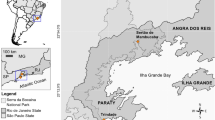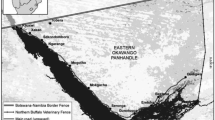Abstract
National parks have been the centre piece of international conservation strategies in developing countries. The expansion in the network of national parks has enabled the conservation of biodiversity and habitats but the acquisition of vast areas into the park system has often been achieved through the displacement of resident local communities. Displaced people are exposed to a variety of impoverishment risks and this stokes up animosity towards parks. The research reported here seeks to understand the key issues involved in the occupation of a section of Gonarezhou National Park by Headman Chitsa’s people. The paper examines how the interplay between the history of displacement and dispossession, demographic pressures, limited economic opportunities, the ‘fast track’ land reform programme and dynastic politics are fomenting the land conflict between Gonarezhou and Chitsa community. Secondary actors with diverse interests have also come into the fold. Official efforts to resolve the conflict using a top-down approach have yielded little success. This culminated in a shift towards the use of traditional mechanisms of resolving a chieftaincy dispute as a step towards addressing the broader parks-people land conflict. Lessons from the case study are, inter alia, that interventions aimed at resolving parks-people conflicts should be alive to local culture, livelihood needs and power dynamics and, to the extent possible, eschew forcible relocations. Finally, we draw attention to the need to address the wider contradiction between policies promoting wildlife conservation and those promoting agriculture. The article is written to share lessons with readers interested in parks-people conflicts.


Similar content being viewed by others
Notes
Bio-Hub is a consortium of CIRAD, World Wildlife Fund for Nature, IUCN and IGF.
The authors participated in these discussions.
Interview with Chief Charumbira at Parliament Building, Harare December 2007.
References
Adams W, Hulme D (2001) Changing narratives, policies & practices in African conservation. In: Hulme D, Murphree M (eds) African wildlife and livelihoods. James Currey, Oxford
Adams W, Hutton J (2007) People, parks and poverty: political ecology and biodiversity conservation. Conserv Soc 5(2):147–183
Amend S, Amend T (eds) (1995) National parks without people? The South American experience. IUCN, Gland, Switzerland
Anderson D, Grove R (1987) The scramble for Eden: Past, present and future in African conservation. In: Anderson D, Grove R (eds) Conservation in Africa: people, policies and practice. Cambridge, Cambridge University Press
Bannerman JH (1980) A short political and economic history of the Tsovani, Chitsa and Mahenye dynasties of Ndanga, Chiredzi and Chipinge districts to CA.1950. National Archives, Zimbabwe Access No. 32514
Beinart W (1989) Introduction: the politics of colonial conservation. J South Afr Stud 15(2):143–162
Brockington D (2002) Fortress conservation: the preservation of the Mkomazi Game Reserve in Tanzania. James Currey, Oxford
Brockington D, Homewood K (1996) Wildlife, pastoralists and science: debates concerning Mkomazi Game Reserve, Tanzania. In: Leach M, Mearns R (eds) The lie of the land. James Currey, Oxford
Brockington D, Igoe J (2006) Eviction for conservation: a global overview. Conserv Soc 4(3):424–470
Carruthers J (1995) The Kruger National Park: a social and political history. University of Natal Press, Pietermaritzburg
Central Statistical Office (1992) Census 1992: Zimbabwe national report. Central Statistical Office, Harare
Cernea M (1997) Hydropower dams and social impacts: a sociological perspective. World Bank Environment Department Paper No. 16
Cernea M (2006) Setting new standards for conservation: displacement redefined. BioSoc: The Biodiversity and Society Bulletin Issue 6, August 2006
Cernea M, Schmidt-Soltau K (2003a) Biodiversity conservation versus population resettlement: risks to nature and risks to people. Paper presented at the international conference on rural livelihoods, forests and biodiversity, Bonn, Germany, 19–23 May 2003. http://www.cifor.cgiar.org/publications/corporate/cd-roms/bonn-proc/pdfs/papers/T4_FINAL_Cernea.pdf. Accessed Jan 2009
Cernea M, Schmidt-Soltau K (2003b) The end of forcible displacements? Making conservation and impoverishment incompatible. Policy matters 12:42–52
Chaumba J et al (2003) New politics, new livelihoods: Changes in the Zimbabwean lowveld since the farm occupations of 2000. Sustainable Livelihoods in Southern Africa Research Paper 3. Institute of Development Studies, Brighton
Child B (2004) Introduction. In: Child B (ed) Parks in transition. Earthscan, London
Colchester M (2002) Salvaging Nature: indigenous people, protected areas and biodiversity conservation. http://www.wrm.org.uy/subjects/nature.html. Accessed Jan 2009
de Wet C (2000) The experience with dams and resettlement in Africa. http://www.dams.org. Accessed Jan 2009
Dowie M (2005) Conservation refugees: when protecting nature means kicking people out. Orion 1:6–27
Economic Commission for Africa (2007) Relevance of African traditional institutions of governance. ECA, Addis Ababa. http://www.uneca.org. Accessed Jan 2009
Emerton L (1999) Balancing the opportunity costs of wildlife conservation for communities around Lake Mburo National Park, Uganda. Evaluating Eden Discussion Paper No. 5. IIED, London
Escobar A (1999) After nature: steps to an anti-essentialist political ecology. Curr Anthropol 40:1–30
FAO (2007) Negotiation and mediation techniques for natural resource management. File://E:\FAO-negotiation and mediation techniques for natural resource management.htm. Accessed Nov 2007
Feeney T (1993) The impact of a European Community Project on peasant families in Uganda. Oxfam Briefing No. 6:1–7
Griffin J et al (1999) Study on the development of transboundary natural resource management in southern Africa. Biodiversity Support Programme, Washington DC
Haas P (1992) Introduction: epistemic communities and international policy coordination. Int Organ 46:1–36
Hulme D, Murphree M (2001) Community conservation in Africa: an introduction. In: Hulme D, Murphree (eds) African wildlife and livelihoods. James Currey, Oxford
Infield M (2003) National parks as cultural entities. Policy matters 12:64–70
IUCN (1994) Guidelines for protected area management categories. IUCN, Gland, Switzerland and Cambridge, UK
IUCN (2005) Benefits beyond boundaries: Proceedings of the Vth World Parks Congress. IUCN, Gland, Switzerland and Cambridge, UK
Jackson P (1992) Maps of meaning. Routledge, London
Jacques AA (1938) Swivongo swa Machangana. Morija, Lesotho
Keeley J, Scoones I (1999) Understanding environmental policy processes: a review. IDS Working Paper 89
Kothari A (2004) Displacement fears. Frontline 21(26) http://www.flonnet.com/fl2126/stories/20041231000108500.htm. Accessed Jan 2009
Kramer R et al (eds) (1997) The last stand: protected areas and the defence of tropical biodiversity. Oxford University Press, New York
Lan D (1985) Guns and rain: guerrillas and spirit mediums in Zimbabwe. James Currey, London
Leach M, Mearns R (1996) Environmental change and policy: challenging received wisdom in Africa. In: Leach M, Mearns R (eds) The lie of the land: challenging received wisdom on the African environment. James Currey, Oxford
Maloka T (1996) Populism and the politics of chieftaincy in the new South Africa. J Contemp Afr Stud 14(2):173–196
Mamdani M (1996) Citizen and subject: contemporary Africa and legacy of late colonialism. Princeton University Press, Princeton
McIvor C (1994) Management of wildlife, tourism and local communities in Zimbabwe. UNRISD, Geneva
Millennium Ecosystem Assessment (2005) Living beyond our means: natural assets and human well-being. http://www.mea.org. Accessed Dec 2007
Mombeshora S (2002) The Mahenye manage wildlife for revenue and economic infrastructure. In: Plastrik P (ed) Sustainable solutions: building assets for empowerment and sustainable development. Ford Foundation, New York
Mombeshora S (2005) Collaborative partnerships in transboundary wildlife management: a review of southern African experiences. IUCN-ROSA, Harare
Mombeshora S (2006) Assessment of livelihoods in Chitsa settlement in Gonarezhou National Park. Bio-Hub, Harare
Moore D (1998) Clear waters and muddied histories: environmental history and the politics of community in Zimbabwe’s Eastern Highlands. J South Afr Stud 24(2):377–404
Murombedzi J (2003) Pre-colonial and colonial conservation practices in Southern Africa and their legacy today. In: Whande W et al (eds) Local communities, equity and conservation in Southern Africa. PLAAS; ART & TILCEPA, Cape Town
Murphree M (2001) Community, council and client: a case study in environmental development from Mahenye, Zimbabwe. In: Hulme D, Murphree M (eds) African wildlife and livelihoods. James Currey, Oxford
Neumann RP (1998) Imposing wilderness: struggles over livelihood and nature preservation in Africa. University of California Press, Berkeley
Oilwatch, World Rainforest Movement (2004) Protected areas: protected against whom?. WRM, Moreton-in-Marsh, UK
Pearce D (2005) Paradoxes in biodiversity conservation. World econ 6(3):57–69
Peters P (2002) Grounding governance: power and meaning in natural resource management. In: Benjaminsen TA et al (eds) Contested resources: challenges to the governance of resources in Southern Africa. PLAAS, Cape Town
Pimbert MP, Pretty JN (1995) Parks, people and professionals. UNRISD, Geneva
Rangarajan M, Shahabuddin G (2006) Displacement and relocation from protected areas: towards a biological and historical synthesis. Conserv Soc 4(3):359–378
Ranger T (1989) Whose heritage? The case of the Matobo National Park. J South Afr Stud 15(2):217–249
Ranger T (1999) Voices from the rocks: nature, culture and history in the Matopos Hills of Zimbabwe. James Currey, Oxford
Rycroft A (2002) Environmental conflict resolution. In: IUCN (ed) Conflict management in transboundary natural resource management in Southern Africa. IUCN-ROSA, Harare
SAFIRE (2004) Land use and tenure on contested land: Chitsa community in Gonarezhou National Park, SE Zimbabwe. IUCN, Harare
Scherl LM et al (2004) Can protected areas contribute to poverty alleviation? Opportunities and limitations. IUCN, Gland Switzerland & Cambridge, UK
Schmidt-Soltau K (2005) Is forced displacement acceptable in conservation projects? ID21 Insights. http://www.Id21.org/insights. Accessed Jan 2009
Schmidt-Soltau K, Brockington D (2007) Protected areas and resettlement: what scope for voluntary relocation? World Dev 35(12):2182–2202
Steenkamp C, Uhr J (2000) The Makuleke land claim: Power relations and community based natural resources management. Evaluating Eden Series Discussion Paper No. 18. IIED, London
Taylor RD (1990) Zimbabwe. In: Allin CW (ed) International handbook of National Parks and Nature Reserves. Greenwood, CT
Taylor JJ (2007) The San court case. Anthropol Today 23(5):3–5
Terborgh J (1999) A requiem for nature. Island Press, Washington DC
UNDP (2003) Human Development Report 2003: millennium development goals: a compact among nations to end human poverty. Oxford University Press, New York
Van der Linde H et al (2001) Beyond boundaries: Transboundary natural resource management in sub-Saharan Africa. Biodiversity Support Programme, Washington, DC
Van Donge JK (2001) One people, one Chief: African chieftainship in the modern world. A case of southern Malawi. In: Andersson J, Breusers M (eds) Kinship structures and enterprising actors: Anthropological essays on development. Ponsen & Looijien, Wageningen
Vicente G et al (2003) Limpopo National Park Business Plan 2004–2006. Ministerio do Turisimo, Maputo
West P et al (2006) Parks and peoples: the social impact of protected areas. Annu Rev Anthropol 35:251–277
Wolmer W (2003) Transboundary conservation: the politics of ecological integrity in the Great Limpopo Transfrontier Park. Sustainable livelihoods in Southern Africa Research Paper 4. Institute of Development Studies, Brighton
Wolmer W et al (2004) Wildlife management and land reform in southeastern Zimbabwe: a compatible pairing or a contradiction in terms? Geoforum 35(1):87–98
Acknowledgments
The authors would like to thank FFEM for funding through the Bio-Hub platform. However, the views expressed in this paper are the responsibility of the authors. The authors would also like to express their immense gratitude to the reviewers of Biodiversity and Conservation for constructive comments that have enriched our treatment of parks-people conflicts. We would also like to thank the Chitsa Task Force and the Chitsa people for making our research possible. Finally, we would like to thank participants at the symposium held in Tapoa, Niger for comments on our presentation.
Author information
Authors and Affiliations
Corresponding author
Rights and permissions
About this article
Cite this article
Mombeshora, S., Le Bel, S. Parks-people conflicts: the case of Gonarezhou National Park and the Chitsa community in south-east Zimbabwe. Biodivers Conserv 18, 2601–2623 (2009). https://doi.org/10.1007/s10531-009-9676-5
Received:
Accepted:
Published:
Issue Date:
DOI: https://doi.org/10.1007/s10531-009-9676-5




